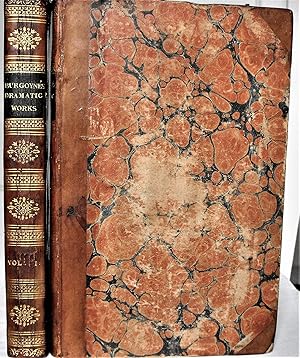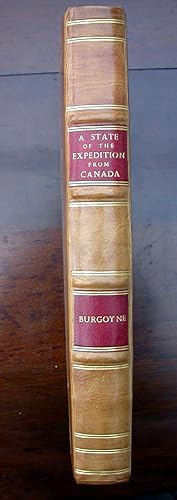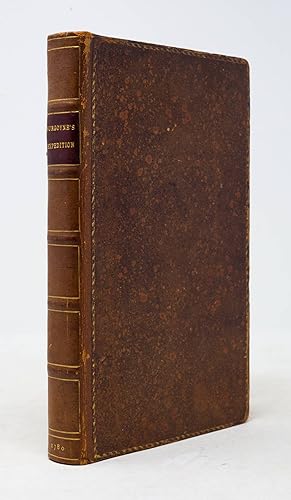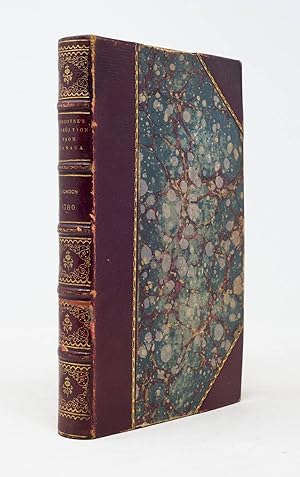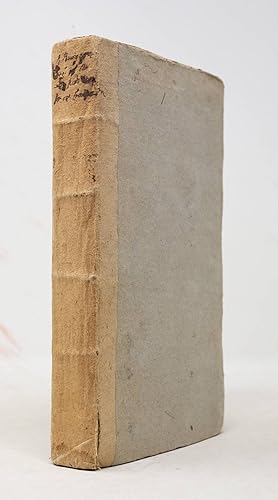Burgoyne, John Lieutenant General (10 results)
Product Type
- All Product Types
- Books (10)
- Magazines & Periodicals
- Comics
- Sheet Music
- Art, Prints & Posters
- Photographs
- Maps
-
Manuscripts &
Paper Collectibles
Condition
- All Conditions
- New
- Used
Binding
- All Bindings
- Hardcover (9)
- Softcover
Collectible Attributes
- First Edition (4)
- Signed
- Dust Jacket
- Seller-Supplied Images (8)
- Not Printed On Demand
Free Shipping
Seller Location
Seller Rating
-
The Dramatic and Poetical Works of the Late Lieut. Gen. J. Burgoyne; to which is prefixed, Memoirs of the Author. Embellished with Copper-Plaes.
Published by London: Printed by C. Whittingham for Scatcherd and Letterman Longman Hurst Rees and Orme; R. Scholey; P. and W. Wynne; J. Booker; J.J. Stockdale; J. Booth; J. Carpenter; R. Ryan; G. Richards; C. Chapple; and H. Ebers, 1808
Seller: John Price Antiquarian Books, ABA, ILAB, LONDON, United Kingdom
First Edition
FIRST COLLECTED EDITION. 2 volumes. 8vo, 207 x 129 mms., pp. [5] 6 - 235 [236 blank]; xii 13] - 248, one engraved plate in volume 1 at page 22, engraved frontispiece and 2 other engraved plates in volume 2, by W. J. White after R. Corbould, complete with four plates as found in other copies, contemporary half calf, gilt spines, olive morocco labels; spines a little dried, some slight browning of title-pages and plates, but a good set with the armorial bookplate of G. P. Rickman on the front paste-down end-paper (pasted over another bookplate) of each volume. Burgoyne (1723 1792) is remembered in American history as the officer who surrendered to the colonists after a desperate and furious battle at Bemis Heights in1777. He had more success as a dramatisst, as Max M. Mintz records in the Oxford DNB: "Burgoyne returned to literary pursuits, having in 1774 authored a play, The Maid of The Oaks, a mix of concealed identities featuring a female advocate of women's equality. The play had been written in two acts as part of the lavish wedding celebrations for Edward Smith Stanley, later twelfth earl of Derby, and Lady Elizabeth Hamilton, held at Burgoyne's home, The Oaks, near Epsom in Surrey. It was later expanded to five acts by David Garrick and became a popular part of the Drury Lane repertory. Burgoyne also wrote political satire, and he achieved a success with a comedy, The Heiress, regarded by contemporaries and later critics as an authentic depiction of upper-class society of the period. Presented in London at the Drury Lane Theatre Royal in 1786, it ran for thirty performances and remained popular in England and on the continent for half a century. Less successful was his libretto for Thomas Linley's adaptation of a French opera, Richard Coeur de Lion (1788)." The Monthly Review gave the volumes a firm endorsement in 1808, describing the work as "A very neat edition of the various offerings to the Muses, which were presented by an accomplished gentleman and a brave and skilful officer.".
-
A Letter From Lieut. Gen. Burgoyne To His Constituents, Upon His Late Resignation
Published by London: Printed For J.Almon, 1779., 1779
Seller: D & E LAKE LTD. (ABAC/ILAB), Toronto, ON, Canada
8vo. pp. 1 p.l., 37, [1]ad. modern bds. Second Edition. Shortly after his capitulation at Saratoga, Burgoyne requested that he be allowed to return to England, where he was greeted with the most intense official criticism and disapprobation. Elected member of parliament for Preston, Burgoyne soon resigned all of his civil and military employments when ordered by the King to return to America and rejoin his captive army. This letter explains his conduct and includes, in the appendix, the King's orders as transmitted by Lord Barrington, and Charles Jenkinson's letters, informing Burgoyne that, in view of the neglect of his duty, the King accepted his resignation. Adams 79-12b. Howes B-962. Sabin 9251. cfJCB II 2530. cfCasey I 576. cfDionne II 836. cfLande 68. cfTPL 6570.
-
A State of the Expedition from Canada as laid before the House of Commons by Lieutenant-General Burgoyne, and verified by evidence, with a collection of Authentic Documents,
Published by Printed for J. Almon, opposite Burligton-house Piccadilly, 1780
Seller: HALEWOOD : ABA:ILAB : Booksellers :1867, PRESTON, United Kingdom
Hardcover. Condition: Very Good. and an addition of many circumstances which were prevented from appearing before the House by the prorogation of Parliament. Written and Collected by Himself, and dedicated to the officers of the Army he commanded. ix, 1,191,cix, blank, six folding engraved plans / maps, elements hand-coloured, two with overlays, small repairs, slight cropped edge to uncut foredge of one map. UNCUT COPY later half calf raised bands, gilt ruled over marbled boards. title with professional corner repair. Second edition. Burgoyne a famous British General of the American Revolution. Defence of his conduct as Commander of the British Expedition to the Hudson Valley from Canada in 1777. Sabin 9255. EXCELLENT COPY OF THIS RARE VOLUME. London 1780.
-
A State of the Expedition from Canada, as Laid before the House of Commons, by Lieutenant-General Burgoyne, and verified by Evidence; With a Collection of Authentic Documents, and an Addition of Many Circumstances which Were Prevented from Appearing before the House by the Prorogation of Parliament. Written and collected by himself, and dedicated to the Officers of the Army he commanded
Published by J. Almon, London, 1780
Seller: Bartleby's Books, ABAA, Chevy Chase, MD, U.S.A.
First Edition
Second edition (first published in quarto the same year). 8vo. ix, (2), 191, (1, duplicate "advertisement" leaf), cix. Six folding maps and plans, with troop emplacements and movements hand-colored, two with overlays showing changes in troop positions, folding table. Howes B-968: "His chief defense against all charges." Sabin 9255: "His very interesting story is told in a masterly manner, and the materials of which it is composed will be held in great estimation by historians, who shall record the events of the unhappy war, to which they owe their birth." Gephart 6179 (this edition). Streeter sale 794 (for the first edition). Sowerby 479 (this edition). Reese Revolutionary Hundred 63 (for the first edition): "Most important source for information about [Burgoyne's expedition down the Hudson Valley in 1777 from Canada, resulting in his disastrous defeat at Saratoga]." Two old independent library bookplates on front pastedown, offset on map and plans, large folding map at the front with some separation from edges of folds. Still a very good copy. Contemporary calf (front joint cracked, but holding), all edges sprinkled blue, gilt rules and leather label on spine. (9802).
-
A State of the Expedition from Canada, as laid before the House of Commons, by Lieutenant-General Burgoyne, and verified by evidence; with a collection of authentic documents, and an addition of many circumstances which were prevented from appearing before the House by the prorogation of Parliament. Written and collected by himself, and dedicated to the officers of the army he commanded
Published by J. Almon, London, 1780
Seller: Arader Books, New York, NY, U.S.A.
Hardcover. Condition: Very good. Second. The Second Edition. London: Printed for J. Almon, 1780. Octavo (8 1/8" x 5", 206mm x 127mm). [Full collation available.] With 6 hand-outlined engraved folding maps (drawn by Medcalfe, engraved by William Faden) and a folding letterpress table. Bound in contemporary speckled calf, rebacked. On the boards, a gilt guilloche roll border. On the spine, five raised bands. Gilt fillet borders in the panels. Title gilt to red morocco in the second panel. Gilt roll to the edges of the boards, continuing onto the inside dentelle. All edges of the text-block glazed yellow. Rebacked. Wear along the fore-edges and fore-corners, with some rubbing at the extremities. Tanned mildly and evenly. A long crease-tear to the large folding map, and some smaller creases and stub-tears to the other maps. Ink ownership inscription on the recto of the first free end-paper: "Wm Burrell/ Broomepark/ 1806". John Burgoyne (1722-1792) was put in command of the British forces in Canada in 1777 after outlining what he considered the errors and insufficient boldness of his own commanding officer, Guy Carleton. His plan was to move south from Quebec and to retake the entire Hudson River valley down to the City of New York, with the aim of stranding New England from southern reinforcement. He got only as far as Saratoga, having failed to coordinate his rendezvous with the forces of Clinton and Howe. On 17 October he surrendered the whole of his army, some 5,800 men, to Horatio Gates. It was the Americans' greatest victory to date, and was crucial in convincing the French to join the fight. Modern historians consider the episode the critical point in the American Revolution's success. "Gentleman Johnny" returned to Britain with Washington's permission in order to defend his conduct, and the present volume is the account of that defense to the House of Commons, and more broadly to rehabilitate his career and to restore his name. That was his sole victory; he would go on to be a Privy Councilor, Commander-in-Chief of Ireland and Colonel of the King's Own Regiment -- to say nothing of a considerable success in the theatre, both on his own and in partnership with Richard Brinsley Sheridan. William Burrell (1773-1847) lived at Broome Park near Alnwick in Northumberland; he was a justice of the peace and High Sheriff of Northumberland in 1811. His family lived at Broome Park from 1658 till 1953, when it was demolished. Howes B968, Lande 69, Sabin 9255.
-
A State of the Expedition from Canada, as laid before the House of Commons, by Lieutenant-General Burgoyne, and verified by evidence; with a collection of authentic documents, and an addition of many circumstances which were prevented from appearing before the House by the prorogation of Parliament. Written and collected by himself, and dedicated to the officers of the army he commanded
Published by J. Almon, London, 1780
Seller: Arader Books, New York, NY, U.S.A.
Hardcover. Condition: Very good. Second. The Second Edition. London: Printed for J. Almon, 1780. Octavo (8 5/16" x 5 1/16", 211mm x 128mm). [Full collation available.] With 6 hand-outlined engraved folding maps and a folding letterpress table. Bound in (slightly later?) half red roan over marbled boards. Gilt roll at the edges of the roan. On the spine, five raised bands. Panels gilt. Title gilt to the second panel, imprint gilt to third. Marbled end-papers (to match the boards). All edges of the text-block speckled red. Rubbed generally, with some spots of wear. Remnants of a paper spine-label in the fifth panel. First free end-paper loose and chipped at the lower edge. Final binder's blank loose. Dampstain to the upper edge, not affecting the text. Mildly and evenly tanned throughout. Armorial bookplate of Baron Eliot to the verso of the initial binder's blank. John Burgoyne (1722-1792) was put in command of the British forces in Canada in 1777 after outlining what he considered the errors and insufficient boldness of his own commanding officer, Guy Carleton. His plan was to move south from Quebec and to retake the entire Hudson River valley down to the City of New York, with the aim of stranding New England from southern reinforcement. He got only as far as Saratoga, having failed to coordinate his rendezvous with the forces of Clinton and Howe. On 17 October he surrendered the whole of his army, some 5,800 men, to Horatio Gates. It was the Americans' greatest victory to date, and was crucial in convincing the French to join the fight. Modern historians consider the episode the critical point in the American Revolution's success. "Gentleman Johnny" returned to Britain with Washington's permission in order to defend his conduct, and the present volume is the account of that defense to the House of Commons, and more broadly to rehabilitate his career and to restore his name. That was his sole victory; he would go on to be a Privy Councilor, Commander-in-Chief of Ireland and Colonel of the King's Own Regiment -- to say nothing of a considerable success in the theatre, both on his own and in partnership with Richard Brinsley Sheridan. The bookplate of the Baron Eliot (motto: praecedentibus insta, press hard upon leaders) belongs either to the first or to the second; in 1815 the second Baron Eliot was created Earl Eliot of St Germans. The former, Edward, Baron Eliot (1727-1804; created Baron Eliot 1784) sat in the House of Commons from 1748-1784, including as member for Cornwall 1775-84, during which General Burgoyne will have made his defense (doubtless Eliot's motto will have been ringing in his ears). The latter, John, Baron Eliot 1804-1815 and Earl of St Germans 1815-1823, also sat in Parliament 1784-1804; he was made Colonel of the East Cornwall Militia. In either case, the connection to Burgoyne (either as his judge or as a fellow military-man) is strong. Howes B968, Lande 69, Sabin 9255.
-
A State of the Expedition from Canada, as laid before the House of Commons, by Lieutenant-General Burgoyne, and verified by evidence; with a collection of authentic documents, and an addition of many circumstances which were prevented from appearing before the House by the prorogation of Parliament. Written and collected by himself, and dedicated to the officers of the army he commanded
Published by J. Almon, London, 1780
Seller: Arader Books, New York, NY, U.S.A.
Hardcover. Condition: Very good. Second. THE NEBENZAHL COPY IN PUBLISHER'S BOARDS. The Second Edition. London: Printed for J. Almon, 1780. Octavo (8 7/8" x 5 3/4", 225mm x 145mm). [Full collation available.] With 6 hand-outlined engraved folding maps (drawn by Medcalfe, engraved by William Faden) and a folding letterpress table. Bound in the publisher's blue drab boards, backed with paper. Title ink manuscript to the front board. Title ink manuscript to the spine. Fore- and bottom edges untrimmed. An entirely unsophisticated copy. The paper-backing party perished, with splits up the hinges, albeit still quite solid. A bit of rubbing to the fore-corners. Very mild even tanning throughout. Maps slightly offset, but otherwise unusually neatly folded and without tears. Bookplate of Kenneth Nebenzahl on the front paste-down. John Burgoyne (1722-1792) was put in command of the British forces in Canada in 1777 after outlining what he considered the errors and insufficient boldness of his own commanding officer, Guy Carleton. His plan was to move south from Quebec and to retake the entire Hudson River valley down to the City of New York, with the aim of stranding New England from southern reinforcement. He got only as far as Saratoga, having failed to coordinate his rendezvous with the forces of Clinton and Howe. On 17 October he surrendered the whole of his army, some 5,800 men, to Horatio Gates. It was the Americans' greatest victory to date, and was crucial in convincing the French to join the fight. Modern historians consider the episode the critical point in the American Revolution's success. "Gentleman Johnny" returned to Britain with Washington's permission in order to defend his conduct, and the present volume is the account of that defense to the House of Commons, and more broadly to rehabilitate his career and to restore his name. That was his sole victory; he would go on to be a Privy Councilor, Commander-in-Chief of Ireland and Colonel of the King's Own Regiment -- to say nothing of a considerable success in the theatre, both on his own and in partnership with Richard Brinsley Sheridan. The survival of the copy in publisher's boards, entirely unsophisticated, explains its ownership by Kenneth Nebenzahl (1927-2020), whose 2012 Christie's sale fetched some $11.6M (the present item was lot 18). He was a dealer of the highest order, specializing in maps. Indeed, the Nebenzahl Lectures in the History of Cartography at the Newberry Library in Chicago (the first speaker was the great authority R.A. Skelton) are among the most important landmarks in the field. Howes B968, Lande 69, Sabin 9255.
-
A State Of The Expedition From Canada, As Laid Before The House Of Commons And Verified By Evidence; with A Collection Of Authentic Documents, And Additions Of Many Circumstances Which Were Prevented From Appearing Before The House By The Prorogation Of Parliament
Published by London: Printed For J.Almon, 1780., 1780
Seller: D & E LAKE LTD. (ABAC/ILAB), Toronto, ON, Canada
First Edition
Hardcover. Condition: Very Good. 1st Edition. 4to. pp. viii, 140, lxii, [1 leaf]ad. 6 folding engraved maps & plans (5 partially coloured; 2 with onlays). 1 table. 19th century half calf (rubbed, joints partly cracked, extremities worn, light dampstain to upper margin of some leaves otherwise very good). First Edition. Burgoyne s defence of his actions in the northern campaign of 1777, which led to his surrender with 6,000 men to General Gates at Saratoga, constitutes one of the best sources on the campaign. His main argument against the criticisms lodged against him in parliament and press was that his army was half the size he had requested, and was badly provided for. The map and plans engraved by William Faden depict the battle positions and actions of the opposing armies: Huberton, the attack at Walmscock, the encampment at Swords House, Braemus Height, the position at Saratoga, and a general map of Lake Champlain and district. Dionne II 841. Howes B-968 (calling incorrectly for only 5 maps). JCB II 2620. Lande 69. Sabin 9255. Streeter II 794. TPL 6576. Vlach 125. cfGagnon I 613 (2nd Edn.).
-
A State of the Expedition from Canada as laid before the House of Commons, and verified by evidence; with a collection of authentic documents, and an addition of many circumstances which were prevented from appearing before the House by the prorogation of Parliament
Published by J. Almon, London, 1780
Seller: Arader Books, New York, NY, U.S.A.
First Edition
Hardcover. Condition: Very good. First. First edition. London: Printed for J. Almon, 1780. Quarto (11 1/8" x 8 15/16", 284mm x 230mm). [Full collation available.] With six hand-colored (outlined) folding engraved maps (drawn by Medcalfe, engraved by William Faden) and overlays on two. Bound in blue boards backed with paper (re-backed to style). Title in ink manuscript to the front board. On the spine, a printed paper label. Fore- and bottom edges untrimmed. Re-backed, with the original paper label preserved. War to the fore-corners, and some scattered soiling to the boards. A light even tanning generally. Some stub-tears and creases to the maps. On the title-page, ownership signature of Hen: Churchill, and, in a different hand, "cost 16s", both in ink. John Burgoyne (1722-1792) was put in command of the British forces in Canada in 1777 after outlining what he considered the errors and insufficient boldness of his own commanding officer, Guy Carleton. His plan was to move south from Quebec and to retake the entire Hudson River valley down to the City of New York, with the aim of stranding New England from southern reinforcement. He got only as far as Saratoga, having failed to coordinate his rendezvous with the forces of Clinton and Howe. On 17 October he surrendered the whole of his army, some 5,800 men, to Horatio Gates. It was the Americans' greatest victory to date, and was crucial in convincing the French to join the fight. Modern historians consider the episode the critical point in the American Revolution's success. "Gentleman Johnny" returned to Britain with Washington's permission in order to defend his conduct, and the present volume is the account of that defense to the House of Commons, and more broadly to rehabilitate his career and to restore his name. That was his sole victory; he would go on to be a Privy Councilor, Commander-in-Chief of Ireland and Colonel of the King's Own Regiment -- to say nothing of a considerable success in the theatre, both on his own and in partnership with Richard Brinsley Sheridan. The present volume is a rather remarkable survival in boards. The owner, Henry Churchill, was perhaps the captain of the East India Company ship Walpole 1783-1793. He was tried in 1791 for harsh treatment of his first mate in Westminster Hall, some few steps from Burgoyne's defense. Howes B-968, Sabin 9255, Staton & Tremaine/PRL 503, Streeter sale II:794.
-
A State of the Expedition from Canada, as laid before the House of Commons, by Lieutenant-General Burgoyne, and verified by evidence; with a collection of authentic documents, and an addition of many circumstances which were prevented from appearing before the House by the prorogation of Parliament. Written and collected by himself, and dedicated to the officers of the army he commanded
Published by J. Almon, London, 1780
Seller: Arader Books, New York, NY, U.S.A.
Hardcover. Condition: Near fine. Second. THOMAS POWNALL'S COPY IN PUBLISHER'S BOARDS. The Second Edition. London: Printed for J. Almon, 1780. Octavo (9" x 5 11/16", 228mm x 147mm). [Full collation available.] With 6 engraved folding maps (by William Faden after Medcalfe) hand-colored in outline, and a folding letterpress table. Bound in the publisher's blue-grey boards, backed with paper. On the spine, author and title ink manuscript. Fore- and bottom edges untrimmed. Entirely unsophisticated. Front hinge starting at the tail to a depth of 35mm. Some wear to the edges of the boards. A few faint passages of tanning. Scattered little tears or creases to the maps. Armorial bookplate of Thomas Pownall to the front paste-down. John Burgoyne (1722-1792) was put in command of the British forces in Canada in 1777 after outlining what he considered the errors and insufficient boldness of his own commanding officer, Guy Carleton. His plan was to move south from Quebec and to retake the entire Hudson River valley down to the City of New York, with the aim of stranding New England from southern reinforcement. He got only as far as Saratoga, having failed to coordinate his rendezvous with the forces of Clinton and Howe. On 17 October he surrendered the whole of his army, some 5,800 men, to Horatio Gates. It was the Americans' greatest victory to date, and was crucial in convincing the French to join the fight. Modern historians consider the episode the critical point in the American Revolution's success. "Gentleman Johnny" returned to Britain with Washington's permission in order to defend his conduct, and the present volume is the account of that defense to the House of Commons, and more broadly to rehabilitate his career and to restore his name. That was his sole victory; he would go on to be a Privy Councilor, Commander-in-Chief of Ireland and Colonel of the King's Own Regiment -- to say nothing of a considerable success in the theatre, both on his own and in partnership with Richard Brinsley Sheridan. Thomas Pownall (1722-1805) was governor of South Carolina, lieutenant-governor of New Jersey and finally governor of the Massachusetts Bay Colony in 1757-1760. In addition to being one of the foremost British colonial administrators, he was himself an author and mapmaker of some distinction; The Administration of the Colonies (1764) with its much lauded cartographic effort by Lewis Evans, was updated by Pownall through 1777. As governor of Massachusetts, he was active in the French and Indian/Seven Years War, and came to understand the dynamics of the thirteen colonies perhaps better than any other Englishman. He came out as an advocate for American independence (though not a staunch one), and sat in Parliament from 1767-1780. Indeed, as the tide was turning for Burgoyne in Saratoga, Pownall gave a speech in the House, predicting the beginning of the end: "I now tell this House and government that the Americans never will return again to their subjection to the government of this country. . . Until you shall be convinced that you are no longer sovereigns over America, but that the United States are an independent sovereign people--until you are prepared to treat with them as such--it is of no consequence at all, what schemes or plans of conciliation this side the House or that may adopt. . ." (2 December 1777) The present item holds a vaunted place in the achievement of American Independence. It is the testament of the agent of British failure in America, belonging to the prophet of British failure. Howes B968; Lande 69; Sabin 9255.


